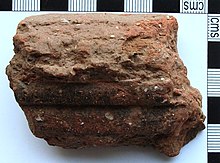Grooved goods
Grooved ware (grooved or notched ware) is a Middle Neolithic ceramic tradition in Great Britain and Ireland (especially in the Boyne Valley). Gordon Childe originally referred to the culture as the Skara-Brae culture after the locality of the same name on the Orkney Islands
Dating
The earliest dates in the Orkney Islands are around 3400 BC. Chr., From 3100 there is a number of secured dates. From 2800 BC The style has also been proven in southern England. The style ends around 2000 BC. Chr.
Subgroups
The Grooved Ware was divided by Ian Kinnes into the four local groups Rinyo (Scotland and Orkney), Clacton (Clacton-on-Sea), Woodlands and Durrington Walls , but show extensive similarities.
Ceramics
The only known shape is a flat-bottomed, deep pot, the walls of which can be straight or slightly bulged. There are two size groups, vessels with an average mouth diameter of 40 cm and those with 10 cm, interpreted by Castleden as cups. The often very dense ornament that covers the outside and the inside edge consists of incised grooves in geometric cordons. Vertical ribs, horizontal ribbons and waves complete the pattern. Linda Hurcombe assumes that the patterns partly mimic baskets. Vessels that have been subjected to lipid analysis often contain residues of pork fat.
distribution
14 C data indicate that the Grooved Ware originated in Scotland, perhaps on the Orkney Islands. The forerunner of the Grooved Ware in Scotland is the Unstan Ware . At the same time, Peterborough goods are commonin the south of Great Britain. Grooved Ware is associated with settlements like Skara Brae and Rinyo in Scotland, Capel Eithin ( Anglesey ), and henges like Durrington Walls and Woodhenge . It is also often found in Timber circles . Grooved Ware was also found in Ireland, along with the characteristic houses (four-post structures), for example in Balgatheran and New Grange .
literature
- Rosamund Cleal, Ann MacSween (Ed.): Grooved ware in Britain and Ireland (= Neolithic Studies Group Seminar Papers. 3). Oxbow, Oxford 1999, ISBN 1-900188-77-5 .
- Terry G. Manby: Grooved ware sites in Yorkshire and the North of England (= British Archaeological Reports. 9, ISSN 0306-1205 ). British Archaeological Reports, Oxford 1974.
- John FS Stone: Some Grooved Ware pottery from the Woodhenge area. In: Proceedings of the Prehistoric Society. Vol. 15, 1949, pp. 122-127, doi : 10.1017 / S0079497X00019241 .
Web links
- Discussion between Cleal and MacSween
- Pictured Grooved Ware Pottery, Boscombe Down, Amesbury
- Relationship between Grooved Ware and Developed Passage Tombs in Ireland engl.
Individual evidence
- ^ Vere Gordon Childe: Prehistoric Communities of the British Isles. London, Chambers 1940.
- ↑ Patrick Ashmore: Radiocarbon dates for settlements, tombs and ceremonial sites with Grooved Ware in Scotland. In: Alex Gibson, Derek Simpson (eds.): Ritual and religion. Essays in Honor of Aubrey Burl. Sutton, Stroud 1998, ISBN 0-7509-1597-8 , 139-147.
- ^ Peter Garwood: Grooved Ware in southern Britain: chronology and interpretation. In: Rosamund Cleal, Ann MacSween (Ed.): Grooved ware in Britain and Ireland (= Neolithic Studies Group Seminar Papers. 3). Oxbow, Oxford 1999, ISBN 1-900188-77-5 , pp. 148-176.
- ↑ Anna J. Mukherjee, Robert Berstan, Mark S. Copley, Alex M. Gibson, Richard P. Evershed: Compound-specific stable carbon isotopic detection of pig product processing in British Late Neolithic pottery. In: Antiquity. Vol. 81, No. 313, 2007, pp. 743-754, here p. 748, doi : 10.1017 / S0003598X00095703 .
- ^ Rodney Castleden: The Stonehenge People. An Exploration of Life in Neolithic Britain 4700-2000 BC. Reprinted Edition. Routledge, London et al. 1998, ISBN 0-415-04065-5 , p. 85, (first edition 1978).
- ↑ Linda Hurcombe: Organics from inorganics: using experimental archeology as a research tool for studying perishable material culture. In: World Archeology. Vol. 40, No. 1, 2008, pp. 83-115, JSTOR 40025315 .
- ↑ Anna J. Mukherjee, Robert Berstan, Mark S. Copley, Alex M. Gibson, Richard P. Evershed: Compound-specific stable carbon isotopic detection of pig product processing in British Late Neolithic pottery. In: Antiquity. Vol. 81, No. 313, 2007, pp. 743-754, here p. 751, doi : 10.1017 / S0003598X00095703 .
- ↑ Rick Schulting, Alison Sheridan, R. Crozier, E. Murphy 2010. Revisiting Quaterness: new AMS dates and stable isotope data from an Orcadian chambertomb. Proceedings of the Society of Antiquaries of Scotland 140, 1-50.
- ^ Graeme Laidlaw, Excavations of the Late Neolithic Grooved Ware site at Scart, Co. Kilkenny. Journal of Irish Archeology 26, 2017, 43. Stable URL: https://www.jstor.org/stable/10.2307/26564120
- ↑ Alison Sheridan 2004. Going round in circles? Understanding the Irish Grooved Ware 'complex' in its wider context. In H. Roche, E. Grogan, J. Bradley, John Coles, Barry Raftery (Eds.), From megaliths to metals: essays in honor of George Eogan . Oxbow, Oxford, 26-37
- ↑ Coilin Ó Drisceoil, Archaeological Excavations of a Late Neolithic Grooved Ware site at Balgatheran, County Louth. Journal of the County Louth Archaeological and Historical Society 27/1, 2009, 77-102. Stable URL: https://www.jstor.org/stable/20789472
- ^ Graeme Laidlaw, Excavations of the Late Neolithic Grooved Ware site at Scart, Co. Kilkenny. Journal of Irish Archeology 26, 2017, 46. Stable URL: https://www.jstor.org/stable/10.2307/26564120
